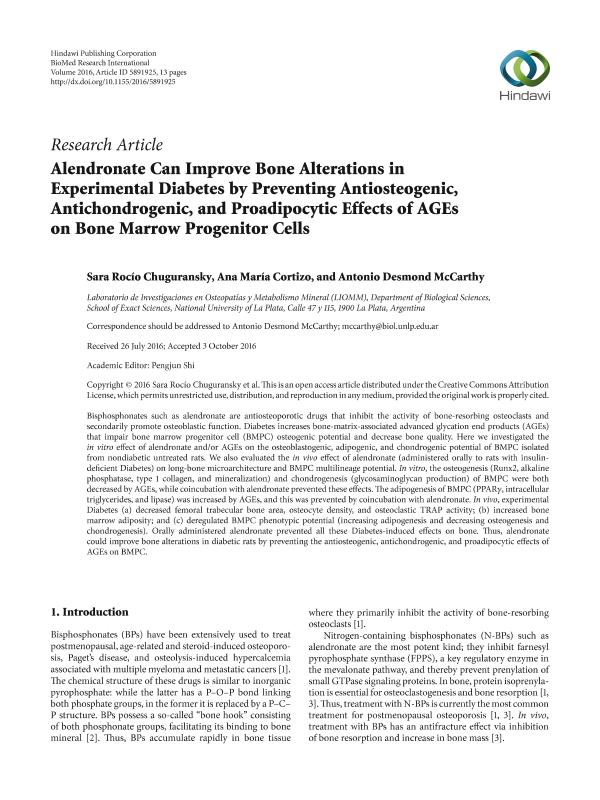Mostrar el registro sencillo del ítem
dc.contributor.author
Chuguransky, Sara Rocío

dc.contributor.author
Cortizo, Ana María

dc.contributor.author
McCarthy, Antonio Desmond

dc.date.available
2018-08-09T17:58:13Z
dc.date.issued
2016-10
dc.identifier.citation
Chuguransky, Sara Rocío; Cortizo, Ana María; McCarthy, Antonio Desmond; Alendronate Can Improve Bone Alterations in Experimental Diabetes by Preventing Antiosteogenic, Antichondrogenic, and Proadipocytic Effects of AGEs on Bone Marrow Progenitor Cells; Hindawi Publishing Corporation; BioMed Research International; 2016; 10-2016; 1-13; 5891925
dc.identifier.issn
2314-6133
dc.identifier.uri
http://hdl.handle.net/11336/54809
dc.description.abstract
Bisphosphonates such as alendronate are antiosteoporotic drugs that inhibit the activity of bone-resorbing osteoclasts and secondarily promote osteoblastic function. Diabetes increases bone-matrix-associated advanced glycation end products (AGEs) that impair bone marrow progenitor cell (BMPC) osteogenic potential and decrease bone quality. Here we investigated the in vitro effect of alendronate and/or AGEs on the osteoblastogenic, adipogenic, and chondrogenic potential of BMPC isolated from nondiabetic untreated rats. We also evaluated the in vivo effect of alendronate (administered orally to rats with insulin-deficient Diabetes) on long-bone microarchitecture and BMPC multilineage potential. In vitro, the osteogenesis (Runx2, alkaline phosphatase, type 1 collagen, and mineralization) and chondrogenesis (glycosaminoglycan production) of BMPC were both decreased by AGEs, while coincubation with alendronate prevented these effects. The adipogenesis of BMPC (PPARγ, intracellular triglycerides, and lipase) was increased by AGEs, and this was prevented by coincubation with alendronate. In vivo, experimental Diabetes (a) decreased femoral trabecular bone area, osteocyte density, and osteoclastic TRAP activity; (b) increased bone marrow adiposity; and (c) deregulated BMPC phenotypic potential (increasing adipogenesis and decreasing osteogenesis and chondrogenesis). Orally administered alendronate prevented all these Diabetes-induced effects on bone. Thus, alendronate could improve bone alterations in diabetic rats by preventing the antiosteogenic, antichondrogenic, and proadipocytic effects of AGEs on BMPC.
dc.format
application/pdf
dc.language.iso
eng
dc.publisher
Hindawi Publishing Corporation

dc.rights
info:eu-repo/semantics/openAccess
dc.rights.uri
https://creativecommons.org/licenses/by-nc-sa/2.5/ar/
dc.subject
Diabetes
dc.subject
Hueso
dc.subject
Alendronato
dc.subject
Cpmo
dc.subject.classification
Otras Ciencias de la Salud

dc.subject.classification
Ciencias de la Salud

dc.subject.classification
CIENCIAS MÉDICAS Y DE LA SALUD

dc.title
Alendronate Can Improve Bone Alterations in Experimental Diabetes by Preventing Antiosteogenic, Antichondrogenic, and Proadipocytic Effects of AGEs on Bone Marrow Progenitor Cells
dc.type
info:eu-repo/semantics/article
dc.type
info:ar-repo/semantics/artículo
dc.type
info:eu-repo/semantics/publishedVersion
dc.date.updated
2018-08-09T15:18:24Z
dc.identifier.eissn
2314-6141
dc.journal.volume
2016
dc.journal.pagination
1-13; 5891925
dc.journal.pais
Egipto

dc.journal.ciudad
Cairo
dc.description.fil
Fil: Chuguransky, Sara Rocío. Universidad Nacional de La Plata. Facultad de Ciencias Exactas. Departamento de Ciencias Biológicas. Laboratorio de Investigación en Osteospatías y Metabolismo Mineral; Argentina. Consejo Nacional de Investigaciones Científicas y Técnicas; Argentina
dc.description.fil
Fil: Cortizo, Ana María. Universidad Nacional de La Plata. Facultad de Ciencias Exactas. Departamento de Ciencias Biológicas. Laboratorio de Investigación en Osteospatías y Metabolismo Mineral; Argentina
dc.description.fil
Fil: McCarthy, Antonio Desmond. Universidad Nacional de La Plata. Facultad de Ciencias Exactas. Departamento de Ciencias Biológicas. Laboratorio de Investigación en Osteospatías y Metabolismo Mineral; Argentina
dc.journal.title
BioMed Research International
dc.relation.alternativeid
info:eu-repo/semantics/altIdentifier/doi/http://dx.doi.org/10.1155/2016/5891925
dc.relation.alternativeid
info:eu-repo/semantics/altIdentifier/url/https://www.hindawi.com/journals/bmri/2016/5891925/
Archivos asociados
